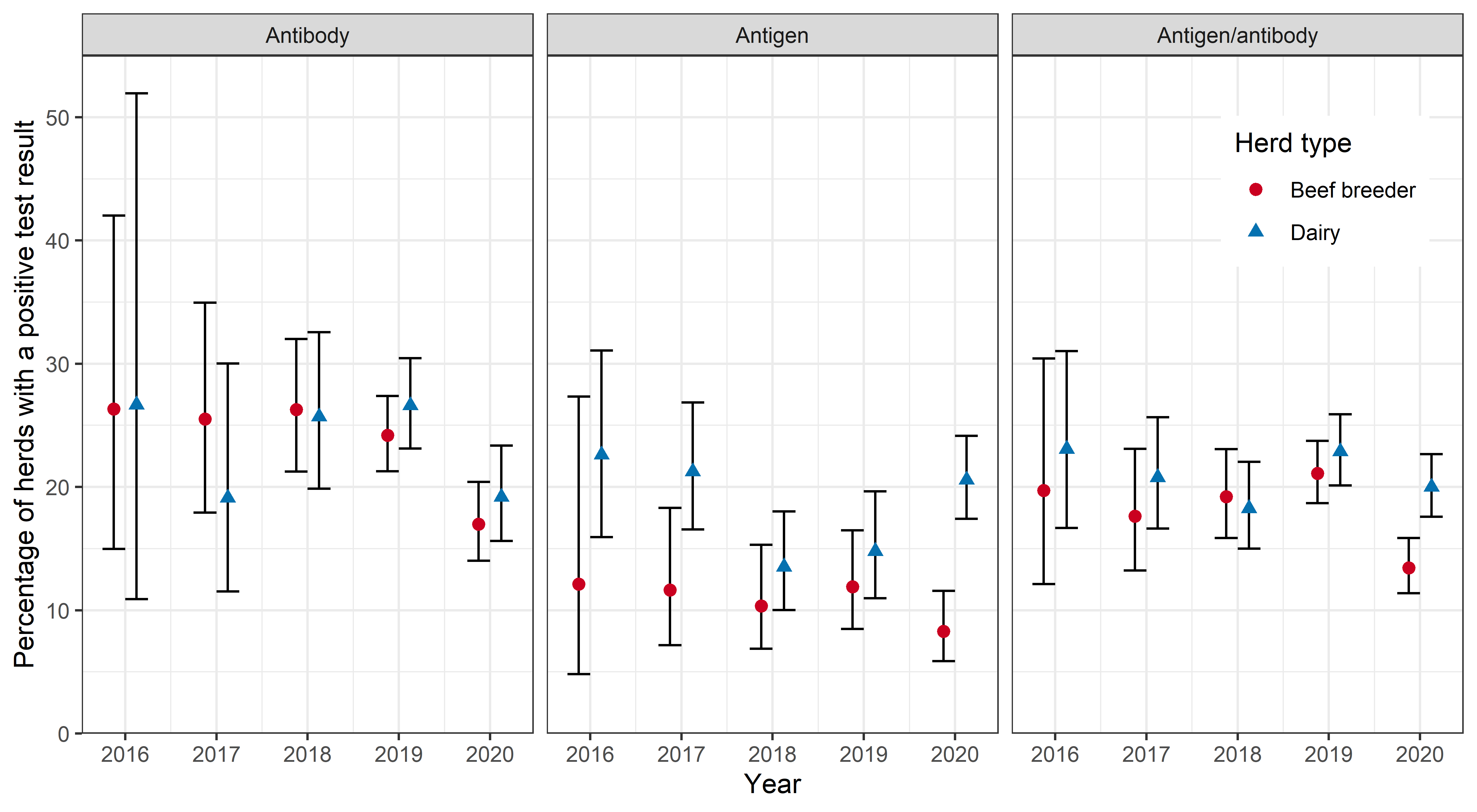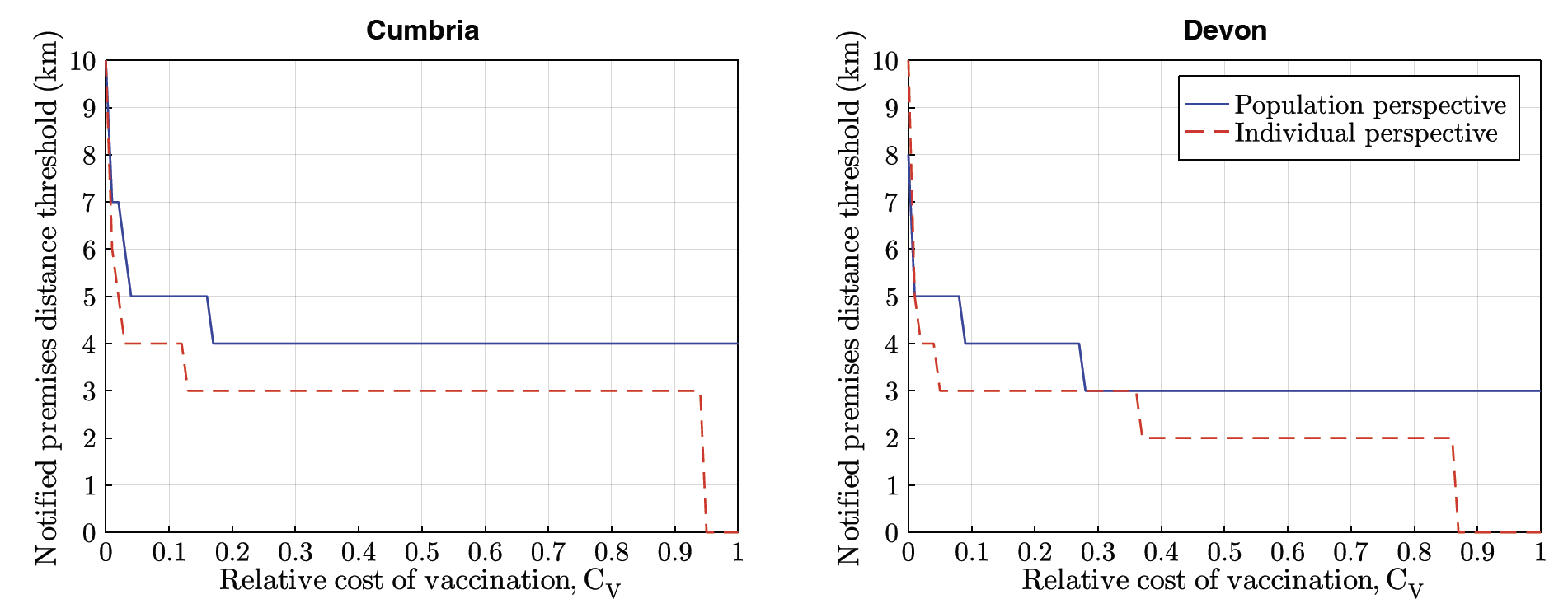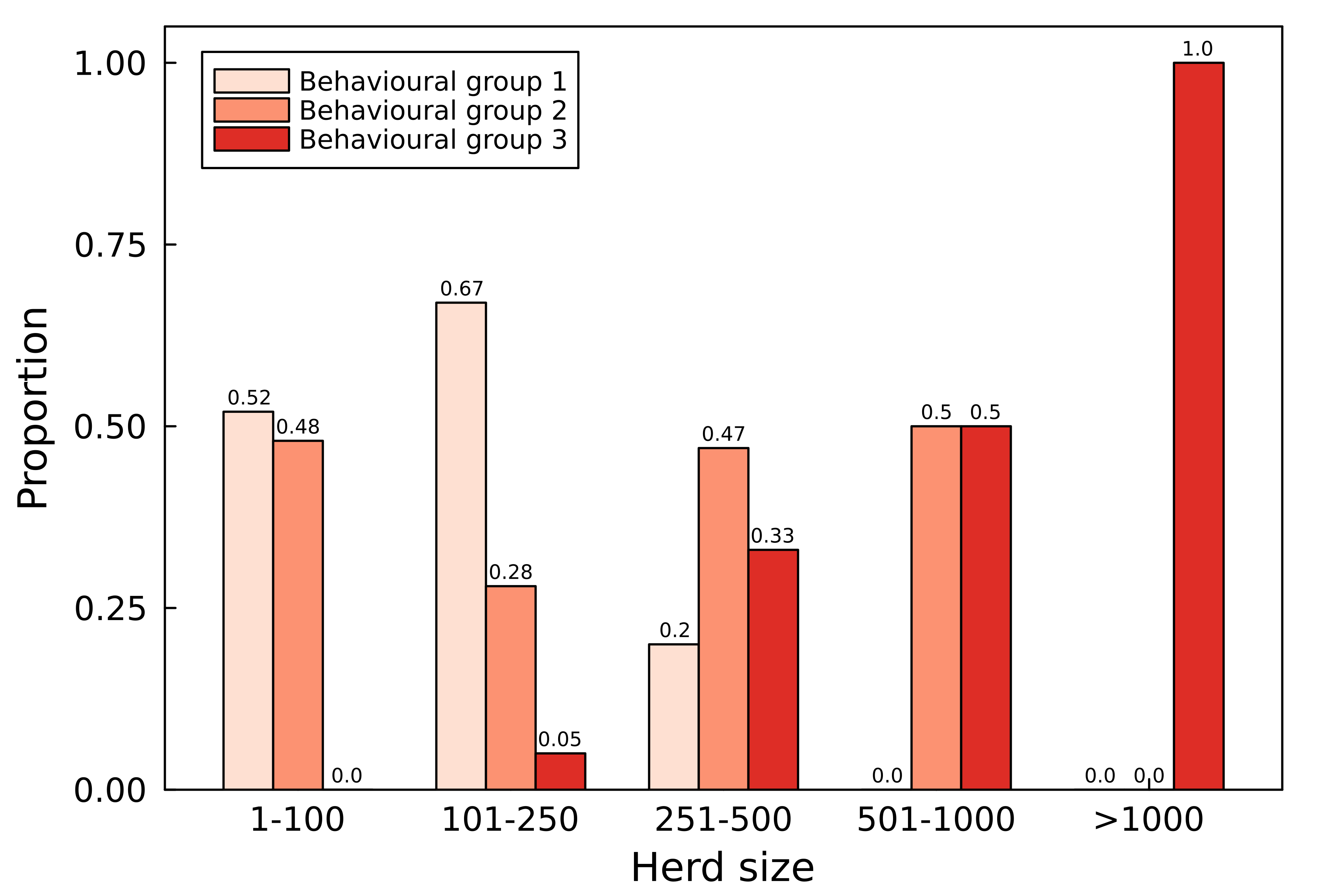FEED research papers
Descriptive analysis of national bovine viral diarrhoea test data in England
BVDFree England is a voluntary bovine viral diarrhoea (BVD) control and eradication scheme for England that has been running since 2016. We analysed the test results submitted to BVDFree England by participating herds from 2016 to 2020 to assess the progress of BVD control in England. Of note, in 2020 20.0% of dairy herds and 13.5% of beef breeder herds had a positive test result, however there was no trend in prevalence of BVD test positive herds over time (see figure). The rest of our findings and continued analysis of test results in subsequent years will be important to assess progress towards BVD eradication in England.
View a Twitter thread summarising the study.
Reference
NS Prosser, EM Hill, D Armstrong, L Gow, MJ Tildesley, MJ Keeling, J Kaler, E Ferguson, MJ Green. (2022) Descriptive analysis of national bovine viral diarrhoea test data in England.
Veterinary Record. 191:e1854. doi: 10.1002/vetr.1854.
URL: https://doi.org/10.1002/vetr.1854

Cattle farmer psychosocial profiles and their association with control strategies for bovine viral diarrhoea
We analysed survey results from 475 UK cattle farmers to investigate how psychosocial factors (altruism, trust and how close farmers feel to other farmers, vets and the Government) and factors from a behaviour change framework were associated with how farmers control bovine viral diarrhoea (BVD) in their cattle. Farmers used many different strategies for BVD control and many psychosocial and behaviour change factors were associated with these. Factors that were associated with farmers carrying out the most proactive BVD controls (using many control methods, or keeping their herd closed and separated from other cattle) were feeling close to the vet, lack of trust in other farmers, having enough time and money to control diseases and a understanding of how and why to control infectious disease.
Reference
NS Prosser, MJ Green, E Ferguson, EM Hill, MJ Tildesley, MJ Keeling, J Kaler. (2022) Cattle farmer psychosocial profiles and their association with control strategies for bovine viral diarrhoea. Journal of Dairy Science. 105:3559-3573. doi: 10.3168/jds.2021-21386
URL : https://doi.org/10.3168/jds.2021-21386
Modelling livestock infectious disease control policy under differing social perspectives on vaccination behaviour
The COVID-19 pandemic has shown how crucial human behaviour is in controlling the spread of an infectious disease. The same is true of livestock, where farmer behaviour is critical to reduce the spread of an infection to enhance animal welfare and reduce economic losses. An ongoing concern for livestock owners is therefore ensuring they have adequate disease management procedures. However, what an individual farmer considers an appropriate way to control an infection in their own livestock may not be the best way to prevent an infection for every farmer’s livestock in the population. We describe a mathematical model combining epidemiological and behavioural elements to study the tension between individual and population-level control of livestock diseases. Applied to representative livestock systems in two counties in England (Cumbria and Devon), and splitting farmers into three types of vaccine behaviour groups (precautionary, reactionary, non-vaccination), we show what individual farmers see as an effective way to reduce infection is not the same as would benefit every farmer. The preferred response to protect every farmer’s livestock is to encourage wider uptake of reactive vaccination, whereas optimising the spatial extent of reactive vaccination for the average individual increases the chance of larger disease outbreaks. View a Twitter thread summarising the study.
Reference
EM Hill, NS Prosser, E Ferguson, J Kaler, MJ Green, MJ Keeling, MJ Tildesley. (2022) Modelling livestock infectious disease control policy under differing social perspectives on vaccination behaviour. PLOS Computational Biology 18(7): e1010235. doi: 10.1371/journal.pcbi.1010235
URL : https://doi.org/10.1371/journal.pcbi.1010235

Incorporating heterogeneity in farmer disease control behaviour into a livestock disease transmission model
Capitalising on interdisciplinary approaches, methodological pipelines are required that can generate novel quantitative data on farmer beliefs (with respect to disease management), process the data into a form that may be amenable for use in mathematical models of livestock disease transmission and refine said mathematical models according to the findings of the data (ensuring notable heterogeneities are captured).
We explored the role of heterogeneous farmer behaviour to inform mathematical models of livestock vaccination, although the concepts and approaches provide key insights into many forms of control. We formulated a novel graphical user interface to dynamically show the progress of a fast, spatially spreading disease outbreak scenario in Great Britain; this was used to elicit when farmers would use an available vaccine. Confronted by such a disease outbreak scenario, we studied how psychosocial and behaviour change factors (trust, psychological proximity, capability, opportunity and motivation) were predictive of farmer vaccination behaviour. Using the attained behavioural groups within an infectious livestock disease model, we showed how the incorporation of heterogeneity in behaviour towards disease management impacts epidemiological outcomes. When assuming homogeneity in farmer behaviour versus configurations informed by the psychosocial profile cluster estimates, the modelled scenarios revealed a disconnect in projected distributions and threshold statistics across outbreak size, outbreak duration and health economic measures.
Also available are our social media threads summarising the study: Twitter, Mastodon.
Reference
EM Hill, NS Prosser, PE Brown, E Ferguson, MJ Green, J Kaler, MJ Keeling, MJ Tildesley. (2023) Incorporating heterogeneity in farmer disease control behaviour into a livestock disease transmission model. Preventive Veterinary Medicine. 106019. doi:10.1016/j.prevetmed.2023.106019
URL : https://doi.org/10.1016/j.prevetmed.2023.106019
Figure




